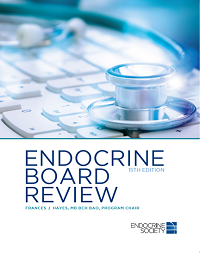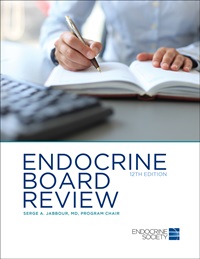Updates to Endocrine Board Review (EBR) can be found on this page.

Male Reproduction Board Review
Stephanie Page, MD, PhD
Pages: 64, 196
Updated: 27 September 2023
Question 8 (Page 64)
Original Text:
Which of the following is the most likely cause of this patient’s SHBG level?
A. Hyperestrogenemia
B. Hypothyroidism
C. Liver disease
D. Obesity
E. Topiramate
Updated Text:
Which of the following is the most likely cause of this patient’s SHBG level?
A. Hyperestrogenemia
B. Hypothyroidism
C. Liver disease
D. Topiramate
Answer 8 (Page 194)
Original Text:
ANSWER: B) Hypothyroidism
Several factors are known to affect the levels of circulating SHBG and therefore testosterone levels in men. This patient has an SHBG level at the lower end of the normal range. Of the answer options listed, only hypothyroidism (Answer B) causes a low SHBG level.
Topiramate (Answer E) (an enzyme inducer), liver disease (Answer C), obesity (Answer D), and estrogen (Answer A) all tend to increase SHBG levels, in which case total testosterone levels are often in the mid-normal to high range, while free testosterone levels are low-normal or low.
Updated Text:
ANSWER: B) Hypothyroidism
Several factors are known to affect the levels of circulating SHBG and therefore testosterone levels in men. This patient has an SHBG level at the lower end of the normal range. Of the answer options listed, only hypothyroidism (Answer B) causes a low SHBG level.
Topiramate (Answer D) (an enzyme inducer), liver disease (Answer C), and estrogen (Answer A) all tend to increase SHBG levels, in which case total testosterone levels are often in the mid-normal to high range, while free testosterone levels are low-normal or low.

Diabetes Mellitus Section 2 Board Review
Michelle Magee
Page(s): 149-171
Update Date: October 8, 2020
Case 42
Original Text: “Octreotide (Answer A), which reduces incretin and insulin secretion, can also be administered; however, its use may be limited by high cost and adverse effects, including diarrhea, steatorrhea, and acute hypoglycemia, most likely due to inhibition of insulin secretion.”
Updated Text: “Octreotide (Answer A), which reduces incretin and insulin secretion, can also be administered; however, its use may be limited by high cost and adverse effects, including diarrhea, steatorrhea, and acute hyperglycemia, most likely due to inhibition of insulin secretion.”
Adrenal Board Review
Tobias Else
Page(s): 7-17
Update Date: August 26, 2020
Case 19
Original Text: “The mass measures 3.4 cm in diameter, the precontrast attenuation value is -5 Hounsfield units, and there is more than 60% contrast medium 15 minutes after contrast administration.”
Updated Text: “The mass measures 3.4 cm in diameter, the precontrast attenuation value is -5 Hounsfield units, and there is more than 60% contrast medium washout15 minutes after contrast administration.”
Calcium & Bone Board Review
Natalie Cusano
Page(s): 18-28
Case 2
Original Text: “Magnesium = 2.3 mg/dL (1.5-2.3 mg/dL).”
Updated Text: “Magnesium = 2.3 mEq/L (1.5-2.3 mEq/L).”
Case 5
Original Text: “Magnesium = 1.6 mg/dL (1.5-2.3 mg/dL).”
Updated Text: “Magnesium = 1.6 mEq/L (1.5-2.3 mEq/L).”
Case 25
Original Text: “Magnesium = 1.9 mg/dL (1.5-2.3 mg/dL).”
Updated Text: “Magnesium = 1.9 mEq/L (1.5-2.3 mEq/L).”
Female Reproduction Board Review
Kathryn Martin
Page(s): 53-58
Case 16
Original Text: “A. Increase the estrogen dosage to a 50-mcg patch.”
Updated Text: “A. Increase the estrogen dosage to transdermal E2 0.05 mg.”